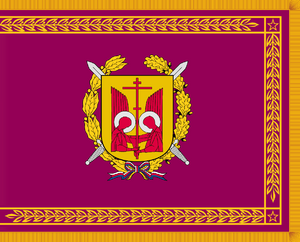Dulebian Armed Forces
| Dulebian Armed Forces | |
|---|---|
| Вооруженные силы Республики Дулебия | |
 Banner of the Dulebian Armed Forces | |
| Founded | 1724 (as the Imperial Dulebian Army) |
| Current form | 1 December 1995 |
| Service branches | |
| Headquarters | Ulich, Dulebia |
| Leadership | |
| Supreme Commander | |
| Minister of Defence | |
| Chief of the General Staff | |
| Manpower | |
| Military age | 18 |
| Conscription | Yes |
| Available for military service | 21,077,703 (2021), age 18-32 |
| Fit for military service | 17,083,554 (2021), age 18-32 |
| Active personnel | 76,000 (2021) |
| Reserve personnel | 185,000 (2021) |
| Expenditures | |
| Budget | Ћ46.6 billion (US$20.9 billion)(2020) |
| Industry | |
| Domestic suppliers | Arms industry in Dulebia |
| Foreign suppliers | |
| Annual exports | Ћ0.52 billion (US$0.23 billion) (2018) |
| Related articles | |
| History | Military history of Dulebia |
| Ranks | Dulebian Armed Forces ranks and insignia |
The Dulebian Armed Forces (Dulebian: Вооруженные силы Республики Дулебия, tr. Vooruzhonnye Sily Respubliki Dulebiya) is a collective term describing the combined military forces of Dulebia, consisting of its Army, Air Force and Navy. The coomander-in-chief of the Dulebian Armed Forces is the President of Dulebia (currently Alexey Volodin).
The history of the Armed forces of Dulebia can be traced byck to the reforms of Peter II the Great in the 1720s. Following the establishment of the Dulebian Empire in 1721, he proceeded to reform its armed formations into a modern Berean army - it was rearmed, retrained and structured in a way similar to that of most Berean empires at the time. It also received a western-style command structure, with the first professional military school in Dulebia being established in 1722. This reformed army showed its effectiveness in the upcoming years in the numerous wars against Dulebia's neighbours. Following the Second Dulebo-Gurkhan War Dulebia received its first naval forces, which rapidly expanded in the 19th century and proved their effectiveness in the Karsk Sea War. In the early 20th century the country also established its Air Fleet Corps, the predecessor of the modern Air Force of Dulebia. After the Dulebian Revolution, the military of the country was once again reformed and restructured, with many of its former commanders fleeing the country or being purged in the early years of the Soviet regime in the country. Despite that, the Dulebian armed forces in the 20th century were one of the biggest in Berea, and one of the few to obtain nuclear weapons in the second half of the century. Following the collapse of the socialist regime in Dulebia, its armed forces were reformed and reorganized. The poor economic situation in the country led to a rapid deterioration of its military, as well as a collapse of the defence industry that was constructed in the decades prior.
Today the Dulebian Armed Forces are a small but potent power in Berea. With an annual spending of Ћ46.6 billion (US$20.9 billion), which forms 2.85% of the country's GDP, the country is around the middle of the list of Berean countries by military spending. Despite numerous reforms and spending increase since the early 1990s, the armed forces still remain equipped mainly with outdated 20th century equipment dating back to the People's Republic of Dulebia. The country is cuurently supplied mostly by its own defence industry, which has seen growth in the first decade of the 21st century due to rising foreign interest in Dulebian military export. While plans to modernize the military and switch to a contract army have been announced, the government spending on the military has been dropping ever since the early 2010s, making all these modernization attempts difficult.